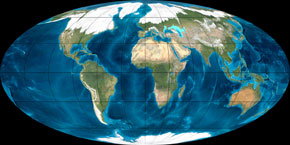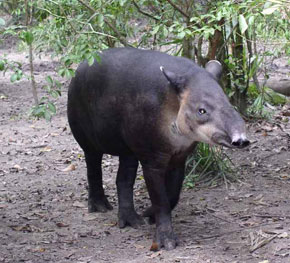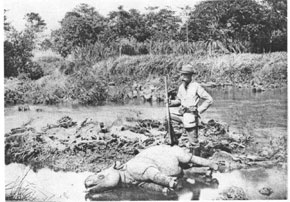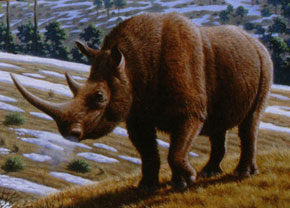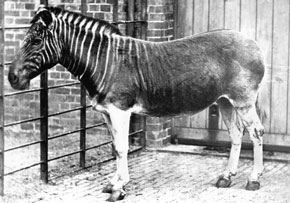Interval 4
Interval 4: Ice Ages

Spring in the Los Angeles Basin during the Pleistocene, about 19,000 years before present. Among the species of mammal present are a saber-toothed cat (Smilodon), dire wolves (Canisdirus), giant ground sloth (Paramylodon) and Columbian mammoths (Mammut huscolumbi). In the background can be seen a herd of the extinct North American horse Equus scotti, which died out at the end of the Pleistocene. Modern day “wild horses” in America are feral populations of the domestic horse Equus caballus. Rob Barber\AMNH.
From 5 MYA onwards the Earth cooled further and underwent several cycles of glaciation, interspersed by periods of warming. The Antarctic ice cap continued to grow and the formation of the Isthmus of Panama, linking North and South America, had major consequences on global temperatures; with warm equatorial ocean currents cut off an Atlantic cooling cycle began, with cold Arctic and Antarctic waters dropping temperatures in the now-isolated Atlantic Ocean. This may have triggered the formation of the Arctic ice cap, which first appeared at around the same time as the formation of the Isthmus, around 3 MYA.
During the Pliocene epoch, the change to an even cooler, dry, seasonal climate had considerable impacts on Pliocene vegetation. Deciduous forests proliferated, coniferous forests and tundra covered much of the north, and grasslands spread on all continents (except Antarctica). Tropical forests, which had once covered wide swaths of both the northern and southern hemispheres, were now limited to a tight band around the equator. Increasing aridity promoted to the spread of dry savannahs and deserts in Asia and Africa. By the end of the Pliocene, around 2.6 MYA, glaciers were forming not just at the poles, but also at middle latitudes.
The Pleistocene epoch, which followed the Pliocene, is often referred to as the “Ice Age” but in fact its 2.6 million year span was made up of four major cycles of glaciation, interspersed with warmer “interglacial” periods. During the glacial periods, ice sheets advanced as far as the 40th parallel in some places and at their maximum extent around 30% of the Earth's surface was covered by ice. A zone of permafrost stretched out hundreds of kilometers from the edge of the continental glaciers, with a mean annual temperature that hovered around freezing point. The amount of water locked up in the glaciers lowered sea levels globally by as much as 100 meters and caused extreme drought and aridity in the unglaciated regions. Forests fragmented and grassland and deserts spread.
By contrast, during some interglacial periods, the climate was even warmer than today. Between 135,000 and 114,000 years ago, average temperatures in Northern Europe were 1 to 2 degrees C higher than they are now. Deciduous forests grew far North of the Arctic Circle, hippos lived in the Thames and Rhine, and in North America the milder climate pushed the boundary of the Great Plains hundreds of miles further West than it lies in modern times.
The severe climatic changes during the ice age had major impacts on the fauna and flora. With each advance of the ice, large areas of the continents became totally depopulated, and plants and animals retreating southward in front of the advancing glacier faced tremendous stress resulting from changes in temperature, reduced rainfall, reduced living space, and curtailed food supply. Nonetheless, the diversity of large mammals during the Pleistocene was much greater than it is today.
Perissodactyls continued to decline in abundance and diversity during the Pliocene and Pleistocene. Rhinos were extinct in North America and there was now only one genus of North American horse, Equus, although this was still comparatively successful and widely-distributed. Tapirs were still present, but in small numbers. The formation of the Isthmus of Panama allowed tapirs to colonize South America, where three species still survive today. Generally, however, the mammals that we think of when we consider the “ice ages” – mammoths, mastodons, saber tooth cats, giant ground sloths - are not Perissodactyls. The one exception is the wooly rhinoceros of northern Eurasia.
The Woolly Rhino: An Ice Age Perissodactyl
The woolly rhinoceros, Coelodonta antiquitatis, lived on the steppe grasslands of Eurasia during the Pleistocene. It was a large animal, standing over 9 feet tall and well over 12 feet in length. It had two horns, the front one over 3 feet in length. Cave paintings show that it was covered in a thick wooly coat of fur; like many mammals that live in cold climates it had short legs, a stocky body, and small ears. Pollen analysis of Coelodonta’s habitat shows an abundance of grasses and sedges and it was well-adapted to graze on these. Studies of its dentition and jaw and neck musculature suggest that it could rip up large mouthfuls of fodder from the ground, important given the low nutritive content of grasses. The wooly rhino disappeared from Western Europe around 15,000 years ago, but may have survived in Western Siberia as recently as 8,000 years ago.
The Pleistocene is an important time for human history. Our species, Homo sapiens, first appears in Africa around 250,000 years ago. Some time between 50 to 100,000 years ago, our ancestors began a long migration out of Africa that ultimately led to our colonization of every continent on Earth. Throughout the later Pleistocene, the arrival of humans seems to coincide with the extinction of large mammal species; the effects are particularly marked in Australia and North America. It is still a subject of debate as to whether humans were directly responsible for these extinctions, or whether they were the result of a combination of factors, including climate change, disease, and hunting (see box 2).
What is clear is that by around 12,000 years ago, perissodactyls had entirely disappeared from North America, bringing an end to 50 million years of evolutionary history. The “wild” horses that are found in the American West today are actually descendants of old world horses, whose distant ancestors migrated out of North American millions of years ago. They were returned to America by Spanish explorers in the 16th Century.
Over-Kill, Over-Chill, or Over-Ill: What caused the Pleistocene Megafaunal Extinctions?
During the last 50,000 years of the Pleistocene, there were worldwide extinctions of mammals. Most of the species affected were large, with a body weight of more than 100lbs – for this reason, these events are referred to as megafaunal extinctions. All continents (with the exception of Antarctica) seem to have been affected, with Australia (95%), South America (80%), and North America (75%) losing the greatest proportions of their large mammal genera. But contrast, only 5% of the large mammal genera in Sub-Saharan Africa went extinct, meaning that modern Africa is the only continent that retains a classical mammalian megafauna. The reasons for this wave of extinctions remain unclear. The most likely cause seems to be human hunting; most of the extinctions occur shortly after the arrival of humans; megafauna on isolated islands survived until much later; and regions where megafaunal communities that had co-evolved with hominids (e.g. Africa and Asia) fared better than ones where humans were a relatively sudden, recent arrival. However some scientists are skeptical that relatively small numbers of human hunters could cause such widespread extinctions in the space of a few thousand years. As an alternative, they propose that the extinctions were caused by extreme climate fluctuations at the end of the Pleistocene and the resulting effects on vegetation patterns and abundance. However, as we have seen, the Pleistocene was a period of major climate fluctuations, that had been going on for millions of years without causing major extinction events. So climate alone cannot explain the disappearance of the large mammals. A third, more radical suggestion, is that humans were indirectly responsible for the extinctions by bringing with them a disease, or diseases, which wiped out native mammal species in the areas that they colonized. However, no evidence of such a “hyper-disease” has been discovered and there is no known disease that could cause the pattern and timing of extinctions seen at the end of the Pleistocene. These hunting, climate, and disease hypotheses are sometimes referred to as the “over-kill,” “over-chill,” and “over-ill” theories.
Perissodactyls Today
Whether or not humans were responsible for the extinction of perissodactyls in North America, our activities today are having a profound impact on the survivors of the group worldwide. Of the 16 species of perissodactyl alive in the wild today, only two are categorized by the International Union for the Conservation of Nature (IUCN) at being of “Least Concern” (the lowest category of risk) and five are classed as “Critically Endangered,” meaning that they are on the verge of extinction in the wild. Three out of the five extant species of rhino fall into this category; the Javan rhino (Rhinoceros sondaicus) is possibly the rarest large animal on Earth, with only 60 individuals surviving in Java and Vietnam. It is a sobering thought that AMNH has 25 times as many specimens of the Miocene rhinoceros Teleoceras in its collections than there are wild Javan rhinos. Hunting, habitat destruction, and illegal trade in rhino horn have all had a catastrophic effect on the perissodactyls and despite aggressive conservation measures it seems likely that at least some species will go extinct in our lifetime due to the ongoing effects of increasing human populations and climate change. But one species of perissodactyl, the horse, has actually benefited from human activities. There are over 300 different breeds of horses in the world today, developed for many different uses. Horses are used for transportation, for agriculture, for medicine, and for leisure. Horses are deeply engrained in human art and culture and are one of the most highly regarded domestic animals.

